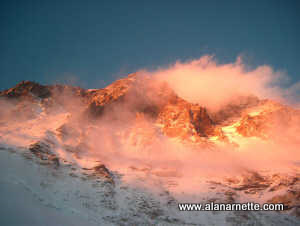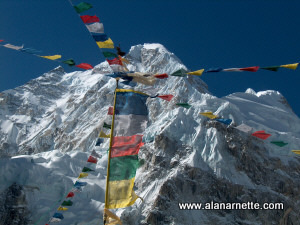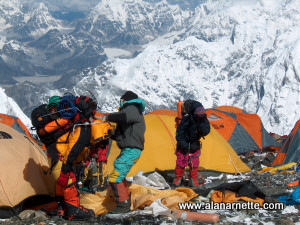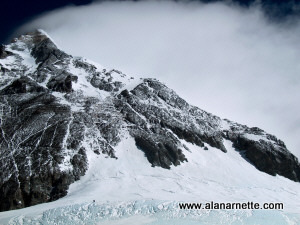
2006
- 12 Dead: What is going on with Everest?
|
 |
2006
- 12 Dead: What is going on with Everest?
|
||||||||||
|
|||||||||||
 This has been a deadly year on both sides of Everest. Perhaps the most deaths
since the infamous 1996 spring season. So what was going on this year that made
it so sad for 12 climbers? First a summary. This has been a deadly year on both sides of Everest. Perhaps the most deaths
since the infamous 1996 spring season. So what was going on this year that made
it so sad for 12 climbers? First a summary.Early in the season, a HimEx Sherpa, Tuk Bahadur, died of HAPE on the north side after fixing rope up high. 3 Sherpas, Ang Phinjo Sherpa, Lhakkpa Tseri Sherpa and Dawa Temba Sherpa, died in the Khumbu Icefall when ice collapsed around them. Tomas Olsson died from a fall on the north died after a rappel anchor tore loose. Vitor Negrete died after his north summit. He had summited without using supplemental oxygen. David Sharp died on the north side during his summit bid. Jacques-Hughes Letrange died on his descent after a north summit. Igor Plyushkin died also on the descent on the north. While not on Everest, Pavel Kalny died near the Yellow Band while attempting Lhotse. Details are sketchy. Climbing deaths are always difficult to discuss and my condolences goes out to all the family and friends. It happens every year and some years, like 2006, are worse than others. However Everest has become safer in the past 15 years. AdventureStats has the best facts I have seen and they report that as of 2003, there have been about 2,000 summits since 1922 with 179 deaths or a 9.3% fatality rate. Since 1990, it had dropped to 4.4%. As bad as this sounds, Annapurna is a much more deadly mountain with a summit to death ratio of 2:1 deaths for every summit (109:55). It seems that each tragedy is unique. Sometimes it is the weather or altitude issues and sometimes a fall. Rare, but sometimes there is equipment failure. Sadly, like with pilots in most airplane accidents, sometime the climber is at fault. High altitude mountaineering is not only a physical sport but also a mental one and judgment is the most critical item. The most common mistakes have to do with climbers not recognizing what is happening to their bodies as a result of the altitude. Study after study have measured that cognitive skills become impaired, reasoning suffers and sometimes climbers make bad decisions: Not abiding by their turn-around time or pushing too hard, too fast to reach the summit. Not taking care of their bodies and staying hydrated. There are many reasons.  The only common theme to seven of this year's deaths (other than with the Sherpas and Igor) was that they were not on large commercial expeditions. This is noteworthy for the fact that commercial expeditions, which cost more, tend to run very conservatively and with a large amount of Sherpa support. They typically employ very experienced guides who have the skills to recognize when a climber is not acclimatization properly or having real problems. The climbers who use ground agents, which cost less, and hire their own Sherpas run a slightly bigger risk in that while the Sherpas are incredible, they sometimes will not be as forceful as a western guide in stopping a climber in trouble. With all the crowds you hear about, why don't other climbers help those in need? In an interview, 2006 climbers note "...Wayne Alexander, of Christchurch, told The Telegraph newspaper in Britain: "We came across a chap sheltering under a rock, who was perhaps hours from death. That was probably only 21/2 hours into the climb. ... Told that it had been suggested that Inglis' party should have stopped their ascent and rescued the man, Inglis replied: "Absolutely, that's a very fair comment. Trouble is, at 8500 metres it's extremely difficult to keep yourself alive - let alone keep anyone else alive." That said, other climbers have famously given up their summits to help climbers in need. Yes, there were over 200 summits on both sides but 12 people are dead - 8 on the north - not a successful season in my mind. As the details are revealed Everest was an embarrassment this year to mountaineering and reduced the expeditions on the north to selfish amateurs. Harsh? Unfair? Judgmental? You be the judge. EverestMax has a scathing first person report on their summit bid with comments such as " ... He clearly had HAPE and if left to his own devices was going to die on the mountain. He had no colleagues with him and his Sherpas had abandoned him. I too tried to encourage him to climb the 10m up to the North Col – he couldn't." and another comment "...Eventually I had to clip him into my harness and pull him up to the North Col. His tent was too far away so I just put him in nearest empty tent. Meanwhile Dom had tried to mobilise help from the 7 Summits team - they refused to help despite being a large organisation."  The media has focused on Sharp's death and the "40 climbers passing by without providing aid". Actually that is not true. Sherpas tried to give Sharp oxygen but all he wanted do was "sleep" - a sure sign that death was near - especially at 8000m. Sadly I have helped bury climbers above 7000m and often there was nothing anyone could have done to save the person. But our world likes to point fingers and find the villains. I have been thinking a lot about the deaths, especially the huge difference between the north and south sides. Please let me think out loud for a moment. First - safety net: The south side has a long history of major commercial operators who use the same Sherpas, camps and routes year after year. Yes, this is similar on the north but at one time the operators on the south established an informal network committed to helping one another in an emergency - no questions asked. The network was demonstrated this year with the rescue of injured Sherpas and climbers in the icefall. This network includes IMG, AAI, Adventure Consultants and others. The south also has a group medical clinic that provides assistance to anyone. Second - costs: The permit costs charged by the Nepalese discourage price-sensitive climbers from climbing on the south. The low Chinese permit charges have encouraged the lowest cost operators to focus on the north thus attracting, sometimes, climbers who need more guiding help but do not get it. Seven of the eleven deaths this year were climbers who were not on major commercial expeditions. Third - discipline: The Ministry of Tourism in Nepal manages Everest with a tight first - financially, ecology and safety. For all the jokes, the Liaison Officers do pay attention and report problems. Operators with poor records can be banned. Followers of Everest know the names. Such discipline is sketchy on the north side. Fourth -competition: The south has several majors who compete for the business year after year and most climbers always ask about their safety record. On the north, there is one dominate commercial operator who has such power that they fix ropes and dictate schedules. Their record is perfect for clients and they serve as a model for other operators. But the north needs more large scale commercial operators to bring order to the chaos. Fifth and finally, the climbers themselves: They bring a lot of the problems. While it is seductive to be the first to do this and that; mountaineering is not an X-Games event. It is dangerous, deadly and real. I am afraid that all the commercialism has made Everest seem like a Colorado 14er, Aconcagua or a nice climb in the Alps. While I personally think Hillary has taken his argument too far in that "... it is just ridiculous having 15 or 20 or 30 expeditions all attempting the mountain at the same time." He does have a fair point in comparing his time to now "...We would have definitely abandoned the ambition to reach the summit in order to get the other person to safety." But should another team have to do that? Mountaineering is a sport of intense independence. It is a sport where the participant can find oneself completely alone, without food, water and shelter in mind numbing cold and flesh-freezing winds. The mountain does not care. It is really a test of the climber, not the Hill. Should a climber who has never climbed Everest be allowed to climb Everest? A silly question? Well in so many words, that seems to be the feeling of many in the industry. But that robs people of their dreams - the heart and soul of alpine mountaineering. Sadly many operators will take anyone on an expedition if they have money. There are four tiers of operators: 1) established commercial companies with long histories and stable ownership, 2) budget operators who run safe, no-frills operations, 3) local ground agents who provide basic logistics and Sherpas for the lowest cost and finally, 4) the upstart operators without a track record. The point is you can die on any of these but some have a better record than others. I am actually very disappointed about this year and for the sport I love. I am disappointed that the largest mountaineering web sites just repost dispatches and rarely comment or offer solutions on what is happening. I am disappointed that the large commercial operators continue to post rosy statements about their team’s success and ignore the cancer in their industry. I am disappointed that climbers continue to put their lives at risk based on the lowest cost operators. I am disappointed that climbers die when it could have been prevented. Climbing is a wonderful sport that delivers challenges and rewards rarely found in this day. It should not be the domain of the "professionals" nor the wealthy. But governments, operators and climbers should dedicated themselves to running safe climbs with proper safety nets, qualified staff, sufficient resources and a moral compass.  I wrote an editorial called "When Good Guides Turn Bad” a few years ago that was focused on the problems with guides and how they treated clients. While I do believe the quality of the guides has improved, the industry continues to have serious and deadly issues. Everest 2006 - North has shown that there is still a long way to go. And it is up to the operators to solve it. They have the power, the knowledge and vested interest to make it happen. Until then, what can be done to prevent these deaths? It is critical that all climbers on these high mountains understand the risks they are taking and not depend on the support from other team members, Sherpas, sat phones or helicopters. However for the climbers, never climb alone and climb in the company of someone stronger than you such as a Sherpa or more experienced climber. Check on one another often and honestly. Stay aware of yourself and what is happening to you - especially at altitude. Take care of yourself by drinking, eating and resting properly. Get the best weather forecast you can, check it often and study the history of the mountain. Know the trends and what might be unusual. Don't take chances like leaving too late for the summit or ignoring your turn-around time. Rope up in crevasse areas, speed through dangerous areas of tumbled ice. Listen to your inner voice and those with more experience. But even with all these precautions, climbing is dangerous. Climbing deaths are always sad and devastating to the families. In some ways the sport has become accustomed to them. Some of the most famous names in the sport are of the ones who died doing what they love: Hall, Fischer, Boukreev, Lowe, Lafaille. Some of these died trying to save others. Some worked to promote safety for their sport. Some were just climbers. The sport often takes the best in spite of all their strength and experience. That is the contract every climber signs with the mountain. It is the deal they make with their families. And it is part of the adventure of mountaineering. But changes can and must be made. Until then it will remain "climber beware". |
|